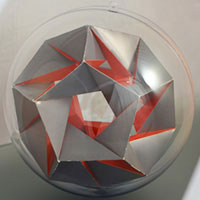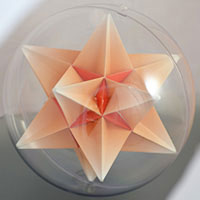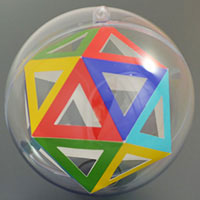

Develop spatial imagination
0.00 $
0 item(s)
The outer sphere of polyhedra

It is rather easy to demonstrate with the example of a square inscribed in a circle. What lies in the word - described or inscribed?
The definition is as follows: The circumscribed circle of a polygon is a circle containing all the polygon vertices.
That is, for the square, each of the four corners must lie on the circle. In our case, the square is exactly inside the circle, and there is no gap between the corners and the circle since all the corners of the square clearly touch the circle. Accordingly, the square was inscribed in a circle. And if we are dealing with three-dimensional geometric bodies, then it can be a matter of inscribing a body in a sphere. And if we are dealing with three-dimensional geometric bodies, then it can be a matter of inscribing a body in a sphere.
The described sphere is a three-dimensional analog of the circumcircle. That is, all the vertices of the polyhedron lie on the surface of the sphere. Immediately, we note that not all polyhedra are lucky enough to have their own sphere, but for example, regular polyhedra (tetrahedron, octahedron, cube, dodecahedron, and icosahedron) can boast about it. All regular polyhedra have the described spheres.

We managed to find a manufacturer of transparent plastic balls, which can also be disassembled and assembled. And this means the following: almost any of the polyhedra constructed from the “Magic Edges” sets can be placed inside a sphere.
First, it allows us to demonstrate how a sphere describes a polyhedron.
Secondly, it is a very aesthetic design that can be hung, protecting the polyhedron from dust.
At the moment, we have spheres with the following diameter:
D = 200 mm
D = 180 mm
D = 160 mm
D = 140 mm
D = 120 mm
We also have models of Platonic solids from the “Magic Edges №12”, which at first glance may seem of different sizes. But there is one relation that unites all these polytopes with their sizes. This is the diameter of the sphere in which you can put all five models. The polyhedra dimensions in the 12th issue were chosen so that the sphere described around the polyhedron was exactly 110 mm.
This can be especially pronounced when comparing the sizes of the icosahedron and the tetrahedron. And now, having a sphere in place that can be disassembled and assembled, we can successively place all the Platonic solids, one after the other.
There is really one small "but". The manufacturer of these transparent “miracle balls” indicates the diameter of the sphere in outer diameter. And since the sphere has a certain wall thickness and anchoring thickness for the join-disconnect operation, the inner diameter will be slightly smaller.
Creating sets of Platonic and Archimedean bodies, we also adhered to the outer sphere diameter size.
Why all this? The situation is this. The set of “Magic Edges №12” (Platonic Solids), the sizes of all five polyhedrons, are selected so that they can be inscribed in a sphere with a diameter of 110 mm. And here, we are talking about a sphere that is ideally thin from a mathematical point of view. Or about a sphere with an inner diameter of 110 mm. Therefore, if you buy a set of spheres with an outer diameter of 110 mm (there are such ones on sale), our five Platonic solids do not fit there. Why? They have an internal diameter of less than 110 mm.
Nevertheless, all our five Platonic solids perfectly fit into balls with an outer diameter of 120 mm. After you close the sphere, there remains a small gap of 4-5 mm, but this can already be attributed to some error.
So, we look - where some polyhedron fits. In a transparent sphere with an outer diameter of 200 mm, polyhedrons can be placed from the issues: 4, 6, 9, 11, 17, 22, and 26.
Popular
Under the guidance of Tatyana Yurievna Timofeyeva, a teacher of mathematics, the guys worked on the...
The Kepler's Star (nor Keplerstjernen), 45 meters high, is located near Oslo in Gardemoen Airport. A huge...
Want to make a fairly complex geometric solid - torus in 10...
When we demonstrate polyhedra assembled from the Magic Edges set, people often ask the same question...
The most famous building in Kazan (a city in Russia) and its main symbol is Tower Syuyumbike. It...
Quite often, a question about the practical use of paper models pops up. What is the point of...
Young British designer, Richard Sweeney, creates amazing paper sculptures. Interestingly, regular...



































